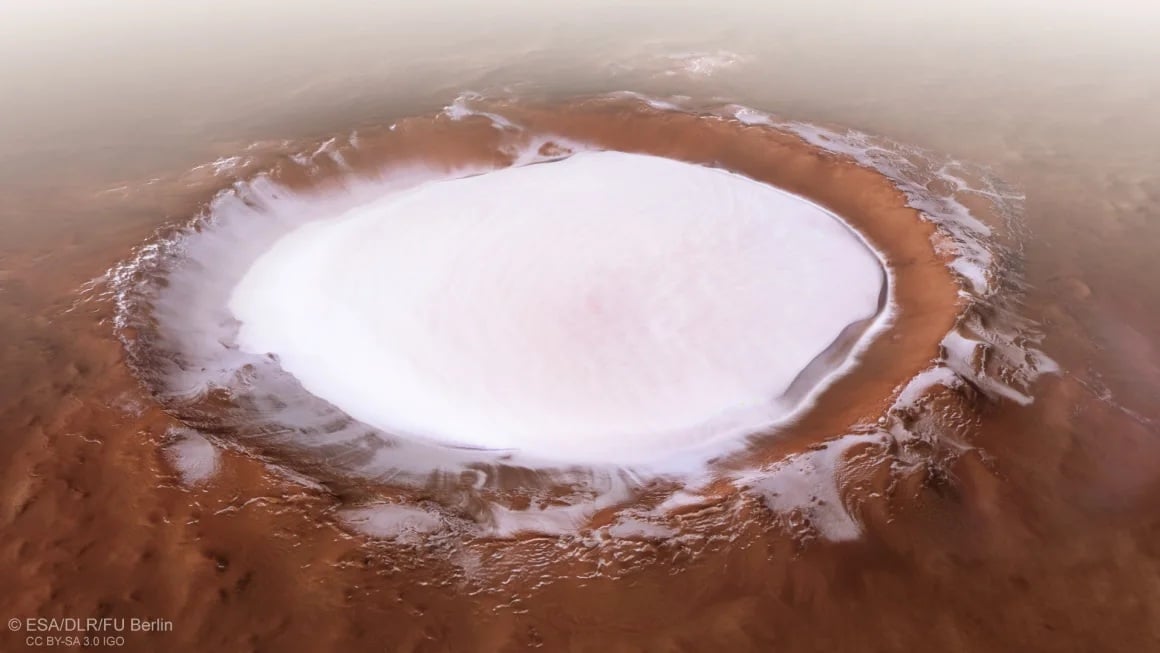Science
Japanese Researchers Uncover Mars’ Ice Age History in Craters

Recent research by a team of Japanese scientists reveals that deep within the craters of Mars, deposits of water ice have preserved the planet’s climatic history. This discovery sheds light on the significant transformations Mars underwent, transitioning from a warmer, wetter environment, characterized by rivers and lakes, to the cold, arid landscape we see today.
Crater Ice Deposits Reveal Mars’ Climate Evolution
For decades, scientists have examined various Martian features that indicate a once-thriving environment. Features such as river channels, delta fans, and sedimentary deposits suggest that Mars hosted extensive bodies of water in its northern hemisphere. However, the questions surrounding the amount of water that once flowed on the planet and the processes that led to its current desiccated state remain critical for understanding Mars’ geological history.
According to a study published in the journal Geology, led by Trishit Ruj, an associate professor at Okayama University, the answers may lie in the ice deposits found within Martian craters. These ice layers act as a historical record, similar to how glaciers on Earth document climatic changes over millennia. The research indicates that Mars experienced multiple ice ages over hundreds of millions of years, with a gradual decline in ice volume over time.
The research team, which included scientists from the Kochi Institute for Core Sample Research, Brown University, and the JAXA Institute of Space and Astronautical Science (ISAS), focused their analysis on glacial landforms in craters located between 20°N and 45°N latitude. They used high-resolution images captured by NASA’s Mars Reconnaissance Orbiter (MRO) to identify features indicative of glaciation, such as ridges and debris from ancient ice sheets.
Climate Cycles and Future Implications
The study revealed that ice deposits consistently formed in the shadowed southwestern walls of these craters, a pattern that remained stable throughout various glacial periods during the Amazonian period, which lasted from approximately 640 to 98 million years ago. Dr. Ruj noted, “Like Earth, these shifts in Mars’ climate were driven by changes in the planet’s axial tilt (obliquity), which is approximately 25 degrees compared to Earth’s 23.4 degrees.
Unlike Earth, however, Mars experiences dramatic changes in its obliquity over time, resulting in glaciation and thawing cycles that have progressively reduced the amount of ice on the planet. The findings indicate that Mars has gradually dried out throughout the Amazonian Era, marking it as the latest and longest geological period in its history.
This research holds significant implications for future crewed missions to Mars. As exploration efforts intensify, understanding the availability of water ice will be crucial for sustaining human life. Future astronauts will need to utilize in-situ resource utilization (ISRU) to grow food, produce oxygen, and generate drinking water from locally sourced ice.
Furthermore, the techniques developed for studying Martian ice can also be applied to Earth. As climate change leads to the shrinking of glaciers and ice caps, the same imaging and modeling methods could help monitor these critical water resources on our planet.
“Mars serves as a natural laboratory for understanding how ice behaves over vast timescales,” said Dr. Hasegawa from Kochi University. “The insights we gain here can sharpen our understanding of climate processes on Earth.”
The research underscores the interconnectedness of planetary science and environmental monitoring, highlighting how our exploration of Mars can inform our responses to climate challenges here on Earth.
-

 Business5 days ago
Business5 days agoUK to Finalize Stablecoin Regulations by 2026, Boosting Crypto Sector
-

 Business5 days ago
Business5 days agoU.S. and U.K. Target Cybercriminal Networks, Seize $15 Billion
-

 World4 days ago
World4 days agoMilitary Artillery Plan Sparks Safety Concerns Along California Highway
-

 Lifestyle5 days ago
Lifestyle5 days agoKISS OF LIFE’s Natty Dazzles in Micro-Shorts at Seoul Event
-

 Sports5 days ago
Sports5 days agoDomenico Doran’s Stellar Performance Leads Bishop Amat to Victory
-

 World5 days ago
World5 days agoTrump Signals Reluctance to Sell Tomahawk Missiles to Ukraine
-

 Business5 days ago
Business5 days agoCalifornia to Eliminate All Plastic Bags from Stores by 2026
-

 Entertainment5 days ago
Entertainment5 days agoLouisiana Senate Raises Concerns Over Medicaid Cuts Amid New Bill
-

 Entertainment5 days ago
Entertainment5 days agoUtah Communities Rally as Government Shutdown Strains Resources
-

 Sports5 days ago
Sports5 days agoTrade Low, Trade High: Key NHL Players to Consider Now
-

 Science2 days ago
Science2 days agoAncient Dinosaur Discovery in Argentina Reveals Evolutionary Insights
-

 Health2 days ago
Health2 days agoUncovering the Hidden Link Between Knee Pain and Hip Issues









